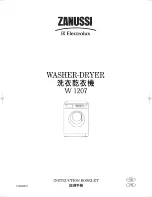
17
Installation instructions
Any electrical and/or plumbing work required to install
this appliance should be carried out by a qualified
electrician and/or plumber or competent person.
Remove all packaging before positioning the machine.
If possible, position the machine next to a water tap and a
drain.
Fitting under a counter
(kitchen worktop or sink)
By removing the machine’s worktop, you can install it under a
close fitting sink unit or a pre-existing top, providing the
dimensions of the recess correspond to those shown in the
picture.
Proceed as follows:
Remove the machine’s worktop by unscrewing the two rear
retaining screws, pull from the front and slide out the rear
slots, lifting the worktop.
Insert the machine after adjusting height and levelling with the
adjustable feet. When inserting the machine, ensure that the
water inlet and drain hoses are not kinked or squashed.
If the dishwasher is later used as a free-standing appliance,
the original worktop must be re-mounted.
The plinth on free-standing appliances is not adjustable.
Levelling
Good levelling is essential for correct closure and sealing of
the door.
When the appliance is correctly levelled, the door will not catch
on either side of the cabinet.
If the door does not close correctly, loosen or tighten the
adjustable feet until the machine is perfectly level.
Water supply connections
This dishwasher must be plumbed into a cold water supply.
The dishwasher is fitted with safety devices that prevent the
wash water returning into the drinking water system and
comply with the applicable plumbing regulations.
The water pressure must be within the limits given in the
"Technical specifications". Your local Water Authority will
advise you on the average mains pressure in your area.
The dishwasher features fill and drain hoses which can be
turned either to the left or the right to suit the installation.
The locknut must be correctly fitted to avoid water leaks.
The water inlet hose must not be kinked, crushed, or entangled
when it is being connected up.
Do not use, for connection, old hoses which have been
used in another appliance.
If the machine is connected to new pipes or pipes which have
not been used for a long time, you should run the water for a
few minutes before connecting the inlet hose.
Water outlet hose connection
The end of the drain hose can be connected in the following
ways:
1. To the sink outlet spigot, securing it to the underside of the
work surface. This will prevent waste water from the sink
running into the machine.
2. Hooked over the edge of the sink using the special curved
plastic guide provided.
3. To a stand pipe provided with vent-hole, minimum internal
diameter 4 cm.
The waste connection must be at a height of between 30 cm
(minimum) and 100 cm (maximum) from the bottom of the
dishwasher.
The drain hose can face either to the right or left of the
dishwasher
Ensure the hose is not bent or squashed as this could prevent
or slow down the discharge of water.
The sink plug must not be in place when the machine is
draining as this could cause the water to siphon back into the
machine.
If you use a drain hose extension it must be no longer than 2
metres and its internal diameter must be no smaller than the
diameter of the hose provided.
Likewise the internal diameter of the couplings used for
connections to the waste outlet must be no smaller than the
diameter of the hose provided.
Attention!
Our appliances are supplied with a security device to protect
against the return of dirty water back into the machine.
If the spigot of your sink has a "no return valve" incorporated
this can prevent the correct draining of your dishwasher.
We advise you therefore to remove it.
820
570 - 600
600
IN05
CS18




































